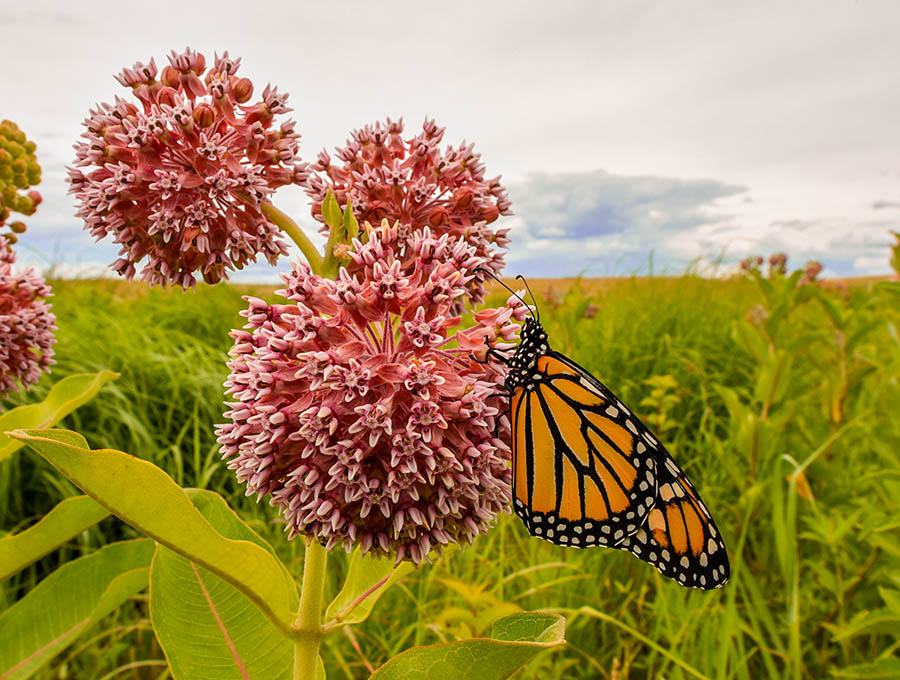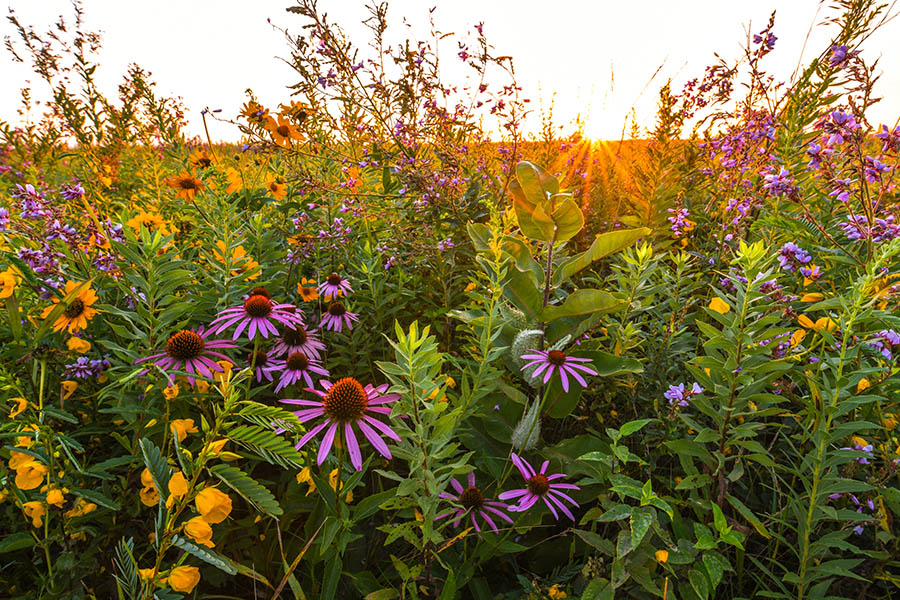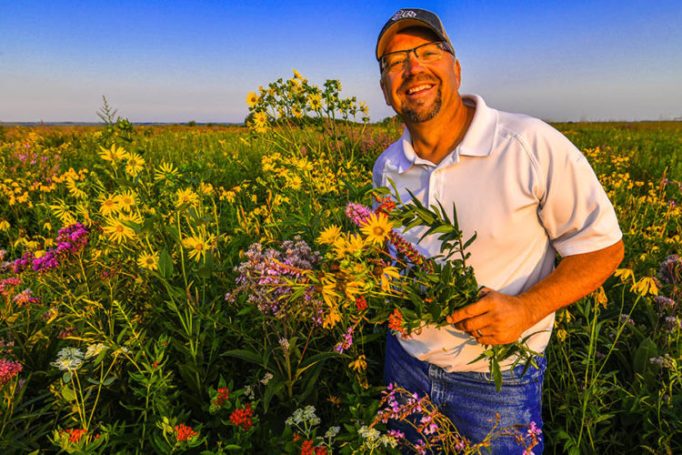What do solar panels and honey bees have in common?
At first glance, not much — though both are great for the environment. But Peter Berthelsen, a Nebraska wildlife conservationist and small business owner, sees an opportunity for an unexpected relationship. After all, he’s spent a 30-plus year career building all kinds of connections: between people and plants, wildflowers and water conservation, insects and songbirds — and solar energy and bees.
As part of his new business, Conservation Blueprint, Berthelsen works with solar development companies to create habitats for honey bees and monarch butterflies at solar panel sites. Instead of planting grass that will need to be mowed or trucking in gravel, Berthelsen designs mixtures of native wildflower seeds to plant on the land, determining which plants can grow best in the shade of the solar panels while creating a pollinator paradise, brimming with nectar and pollen.
“That’s the key to successful partnerships — bringing together multiple interests,” Berthelsen says. “At first you might not connect solar panels and pollinators, but it’s easy to combine those, providing solar panels and pollinator health benefits. In my opinion, it’s really a cool combination.”
With habitat loss being the biggest threat to ever declining populations of pollinators (who are responsible for one out of every three bites of food you take) Berthelsen has dedicated his career to providing homes and forage for butterflies and bees. To accomplish this, he recently broke from the security of a steady gig to start his own business — and he’s never been happier.
Falling Far from the Tree
Growing up, Berthelsen was the bug kid. In third grade, his teacher brought an aquarium filled with monarch caterpillars to class; he watched as the insects transformed into chrysalises and erupted into bright orange butterflies before his class released them into the schoolyard. He was hooked.
“There’s virtually nothing I can remember from the third grade, but I do remember that,” Berthelsen says. “I think that experience had a formative impact.”
Berthelsen decided in 10th grade he’d go to college to study wildlife management. Today he and his wife own a 65-acre ranch, where they cultivate pollinator habitats, harvest wildflower seeds, and provide educational tours to demonstrate sustainable farming practices — a far cry from his suburban upbringing.
“I’m an oddity for sure,” he says. “My passion for conservation goes so far back, and it is such an intrinsic part of my makeup that there was never a conscious decision about what I would do with my life. I just always knew.”
Going Ice Fishing
Berthelsen began his professional career in 1983 by working temp jobs. He bounced around between government organizations like the U.S. Forest Service, Wisconsin Department of Natural Resources, and the Texas Parks and Wildlife Department before landing a job with nonprofit organization Pheasants Forever.
He ended up staying for 27 years, working with corporate, government, and private partners across the country to create and preserve habitats for pheasants. “I loved every minute there and thought I would never leave,” Berthelsen says.
Years into his work with Pheasants Forever, Berthelsen spotted a business opportunity.
“In their mission to develop wildlife habitats and work with private landowners, I saw overlap with pollinators,” he says. “There’s a very clean overlap between what you want for pheasants, quail, honey bees, monarch butterflies, and grassland songbirds. And those overlapping opportunities broaden to include sustainability and water quality, and soil health — pollinators are the glue that connects every single one of those interests.”
He realized there might be a market for working with landowners to design custom habitats crafted to keep pollinators happy and healthy — with the mission of supporting the whole ecosystem. But even with an idea he suspected could both earn a living and make a real difference, Berthelsen put it on the backburner for years.
“I am a very cautious person,” he says. “It took me a while to flip the switch.” In his resignation letter, Berthelsen equated his foray into entrepreneurship to going ice fishing: “It’s early in the season, and I’m not sure how thick the ice is.”
He feared falling through the proverbial ice — but today, his only regret is not taking the plunge sooner.
“I can’t wait to get to work every single day,” he says. “I get to interact with all kinds of different people who have an interest in doing things to benefit wildlife habitat and the environment. I feel like I get to make a difference in something that I am passionate about — how can you do better than that?”
There’s a Seed for That
When it comes to pollinators, not all habitats are created equal. This is a foundational philosophy behind the work of Conservation Blueprint: just because a plant is flowering doesn’t mean it can effectively support honey bees or monarch butterflies.

“Different plants have different qualities,” Berthelsen explains, and each pollinator has unique needs. Monarch butterflies, for example, lay their eggs only on milkweed plants. The very hungry caterpillars chow down on the green leaves, but once they reach the adult stage, they need nectar to survive — which milkweed doesn’t supply.
So if Berthelsen is working with a client who wants to target butterflies, he’ll craft a mix of seeds including milkweed and nectar plants, taking care to include native species and enough variety to keep flowers blooming throughout the growing season. Honey bees, on the other hand, thrive among plants brimming with pollen.
Related: Growing an Herbal Remedy Empire, One Website at a Time
“I’m excited about being able to help people with their objectives, whether they are a commercial beekeeper who wants their bees to be healthier or someone who cares about monarch butterflies,” Berthelsen says. “I design a seed mixture for them to meet their goals. It’s not as simple as, ‘Here are some flowers; the bees will love it.’ You have to be thoughtful to make sure you’re including the plant species that really do provide the maximum value.”
He’s worked with clients from elementary schools and municipalities looking to plant a butterfly garden alongside a playground to farmers wanting to protect a water source.
“A farmer might have a stream running through the area, and they want to plant a buffer between the farmland and the water to filter out the chemicals that are used in agriculture,” he says. “I have seed mixtures that will work here. There’s really a wide range of things where a public, private, or corporate entity could have a need to want to plant something that we can help them with.”
Save the Pollinators
It’s in everyone’s best interest to look out for pollinator habitats.
“A pollinator is anything that gets pollen from the male part of the plant to the female part,” including bats, birds, beetles, along with bees and butterflies, Berthelsen explains. Some plants self-pollinate, but the majority, including 75 percent of the world’s crops, require help from pollinators.
It’s no secret that bee populations have been in decline for years. Problems such as disease, pesticide exposure, and poor nutrition caused by a lack of foraging habitat make it a tough time to be a honey bee. A world without bees would strain to sustain the 7.2 billion-strong human population.
Monarch butterflies are in trouble too. Without any concerted efforts to protect their populations, they have a 60 percent likelihood of extinction in the next 20 years. These butterflies are currently under evaluation for protection under the Endangered Species Act, with a decision expected in June. “It’s sad — we don’t want any species, especially the most iconic insect in the country, to become endangered,” Berthelsen says.
Declining populations are dangerous for crop and plant health, “but we also don’t want the potential ramifications that could come to land management practices that would be an unintended consequence of an Endangered Species Act listing,” Berthelsen says. “It could impact agriculture — when you can spray, what herbicides you can use, roadside mowing. It has the potential to have a significant cascading set of impacts on how agricultural landscapes are managed.”
Save the pollinators and benefit the crops, food supply, and farmers — and it all comes back to habitat. Beyond his business endeavors that support this cause, Berthelsen is engaged in nonprofit work dedicated to making it easier for landowners to build pollinator-friendly habitats. He’s the partnership director for the Bee and Butterfly Habitat Fund, an organization that collects funding to provide free or reduced priced seed mixtures for qualifying 2-acre-plus projects on “private, public, and corporate land in the Midwest — a region of the country key to honey bee and monarch health,” Berthelsen says.
Spreading the Word . . . with Awesome Web Hosting
The world of social media marketing and website building was a mystery to Berthelsen when he first got started. “I’m just a biologist,” he says. He was able to connect with a web designer to build Conservation Blueprint’s website, and she got everything going for him with DreamHost.
“She’s a very smart, capable person, and she was sold on DreamHost,” he says. “I love it; the design looks great.”
His website greets potential clients with idyllic photos of fields of wildflowers and butterflies resting on blossoms — every one captured by Berthelsen, who’s been dabbling in photography since he took pictures for the high school newspaper. “I’m an amateur, but I’m an OK amateur. If you take enough photos, you’re going to get a couple here and there that are pretty good.”
Related: Want to Build a Website in 2019? Here’s Your Game Plan
Along with his beautiful photography, Berthelsen’s website hosts a series of short pollinator habitat tip videos that he produces and publishes once per month, discussing plant species, how to plant and maintain habitats, and more.
“I don’t want to sound like a dinosaur, but how we communicate is completely different from when I started my career,” he says. “Having a website and communicating with people through two-minute video clips about something that you’re passionate about — people have instant access to you. A website where people are like, ‘Those are some good photos!’ gets somebody to give you one or two more clicks. That’s all part of how you make a difference today.”

Shared Hosting That Powers Your Purpose
Whether you’re saving the bees or selling t-shirts, we make sure your website is fast, secure and always up so your visitors trust you.
Choose Your PlanPassion Project
Biologists with a love for all things insects are often stereotyped as introverts who’d rather get lost in the woods than speak to a crowd. And this stereotype isn’t wrong, says Berthelsen — it just doesn’t apply to him.
“I’m on multiple national pollinator committees. Through my roles there and with Conservation Blueprint and Bee and Butterfly Fund, I’m speaking somewhere in the country at least once a month.” He hosts national webinars about resource management; speaks to utility companies, state agencies, and departments of transportation; keynotes national beekeeping conferences; and considers himself lucky to have a voice and influence in work he’s passionate about. “It’s just another part of what makes my job so enjoyable, talking about these subjects with such a wide range of people.”
He’s less than two years into Conservation Blueprint and is more than happy with its success. “I’m focused on building Conservation Blueprint into something that is impactful, makes a difference, and keeps food on the table — and all three of those things are happening.”
Even better, Berthelsen has found a perfect blending of his passions: sustainable ranching, harvesting and growing prairie seeds, and teaching people from all walks about wildlife habitats. “I’ve been very fortunate to be able to thread the needle to where the things that I’m personally passionate about mesh very cleanly with my work, and to me, that’s the holy grail.”

What You Can Do to Help?
This year, give the environment an Earth Day surprise — take your own steps to support healthier pollinators. Even if you don’t own huge tracts of land, Berthelsen offers these tips:
1. Plant a Pollinator-friendly Garden
Berthelsen has 65 acres of pollinator habitat on his property — but you don’t need 65 acres to make a difference. “You don’t even need one acre,” he says “If you build it, they will come. Gardens and parks and backyards can all collectively have a significant impact on pollinator health.”
Remember, not all flowers are created equal. Instead of going for pansies or geraniums in your front yard or porch container garden, plant milkweed or bee-friendly sunflowers and lavender. Monarch butterfly habitats span much of North America, so chances are there’s some nearby that would appreciate your efforts. Look for species of milkweed, nectar, and pollen plants that grow natively in your area and plant your own backyard pollinator habitat.
2. Lobby Local Organizations
Is your city building a new park? Are you on the PTA at your kid’s school? Is your workplace campus updating the landscaping? Suggest to the right people that room is made for pollinator-friendly flora. If you are the right person in these or similar scenarios, make restoring habitats a priority.
3. Support Nonprofits
If you want to help out even more, Berthelsen suggests promoting opportunities and organizations that benefit pollinators. For example, happen to know someone in the Midwest who has two acres of land to manage? Let them know about the Bee and Butterfly Habitat Fund’s free seed mixtures. Track down nonprofits and other groups, especially ones near you, that are working to restore pollinator habitats and find out how you can volunteer, contribute, or donate.
